The Dahlia Center and the Travelling “Stem Cell” Road Show
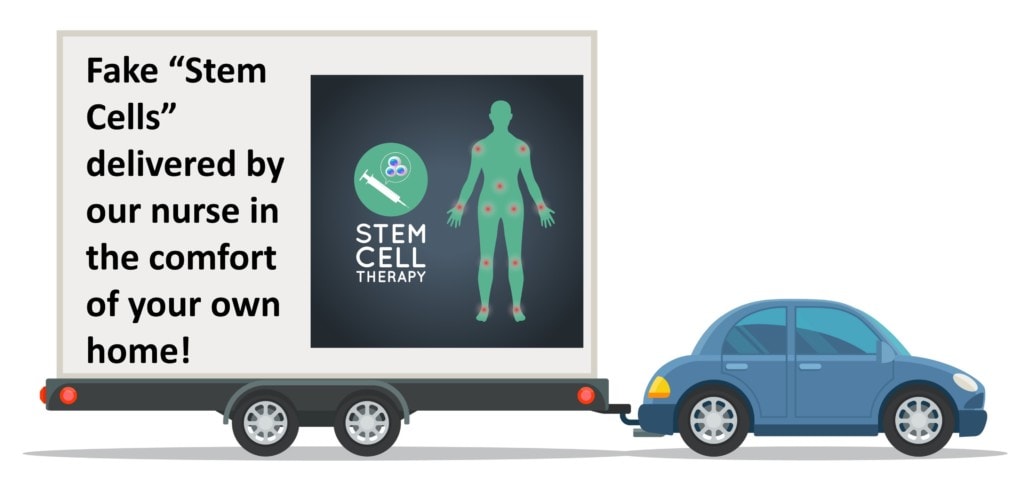
This is a phenomenon that I’ve been following for years, but I’ve been waiting to nail it down better before writing about it. I call it the traveling “stem cell” roadshow. Let me explain.
Before I begin, I’m a physician expert in interventional orthobiologics. What I write below is my opinion based on my expertise and training as well as years of writing about the differences between clinics run by mid-levels and physician specialists who offer orthobiologics. Also, I never know what I’ll find when I decide to spend hours digging into these clinics, so what I uncovered I all learned yesterday and this morning. Finally, the purpose of my commentary and opinion is as always, to educate the public about the risks involved in seeing lesser trained medical providers offering “stem cell” therapy.
A Random Patient
A patient of mine who reads this blog was sent this flyer in the mail:
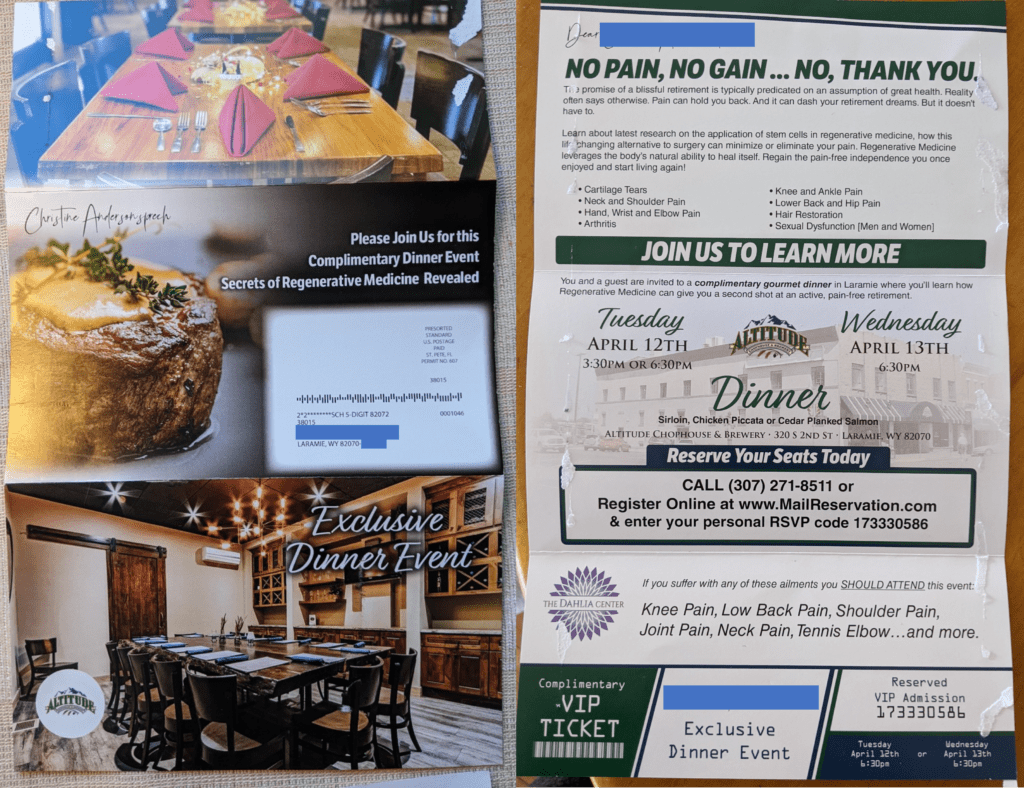
She also mentioned in the email that the clinic that sent it was in OHIO? That kind of threw me because she lives in rural Wyoming, so I called The Dahlia Center in Medina, Ohio. I spoke to the receptionist who confirmed that the clinic sends a nurse practitioner to your home in Wyoming to perform an umbilical cord “stem cell” injection. I tried reaching out to the nurse practitioner who runs this clinic but never got a callback. If I do, I’ll update the blog.
Prior FDA Letter
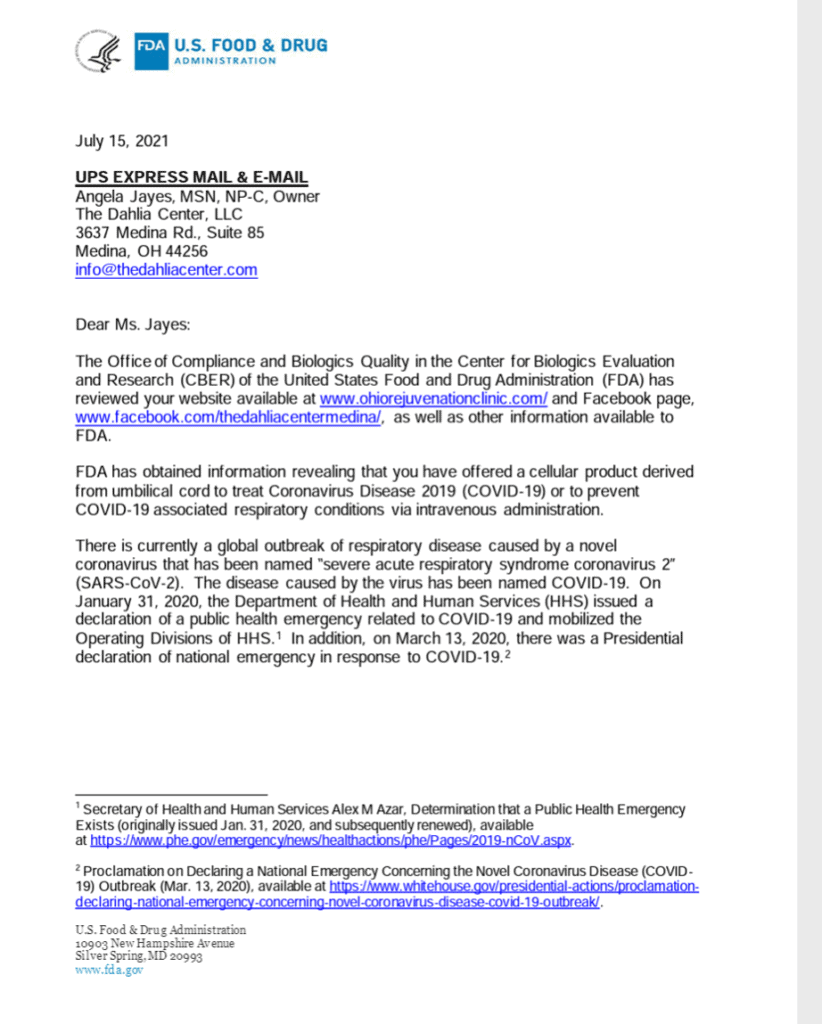
It didn’t take long to figure out that the Dahlia Center and the nurse who runs it (Angela Jayes) received a letter from the FDA dated July 15th, 2021 for their offering of umbilical cord “stem cell” treatment to treat COVID-19 and many other diseases. The diseases that the clinic claimed to be able to successfully treat with umbilical cord tissue included diabetes, autoimmune diseases, leukemia, prostate cancer, congestive heart failure, severe COPD, Lupus, blindness, and Parkinson’s disease! Basically, a good chunk of the incurable diseases in any medical school textbook.
An Interesting Facebook Page
The Dahlia Center website doesn’t say much. However, the Dahlia Center has a Facebook page with all sorts of images that show us what they’re doing. Remember, this is a clinic that lists no physician but only has a nurse practitioner. She seems to be married to a business guy who is listed as the executive officer of the venture.
This is what I found on Facebook:
Low Back Muscle Trigger Point Injections
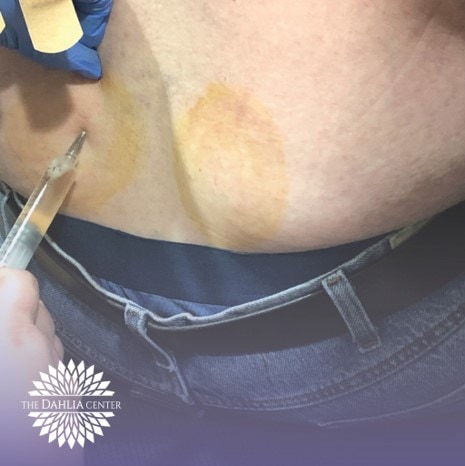
Here we see a blind low back injection where the needle is buried. The low back injection looks like a muscle trigger point injection, so a very low-level procedure. This would be very unlikely to help someone with a bulging disc, sciatica, SI joint pain, facet syndrome, or disc pain. Which is always the problem here. These clinics will often claim that they can treat these diagnoses, but don’t offer sophisticated image-guided spine care, hence you pay big bucks to get fake stem cells injected into your lower back muscles.
To understand that better, here’s the difference between actual interventional spine care and what this image shows us the Dahlia Center is doing to treat low back pain:

Note in the animation above that a real interventional orthobiologics procedure would target deeper structures using imaging guidance and that requires a highly trained physician sub-specialist. What’s maddening for someone who can perform and who has taught those procedures is that places like this will charge huge money for a simple low back trigger point injection that’s often more than we would charge for the real deal requiring C-arm fluoroscopy.
What does a real interventional orthobiologic spine procedure look like? See my video below:
This is Scary
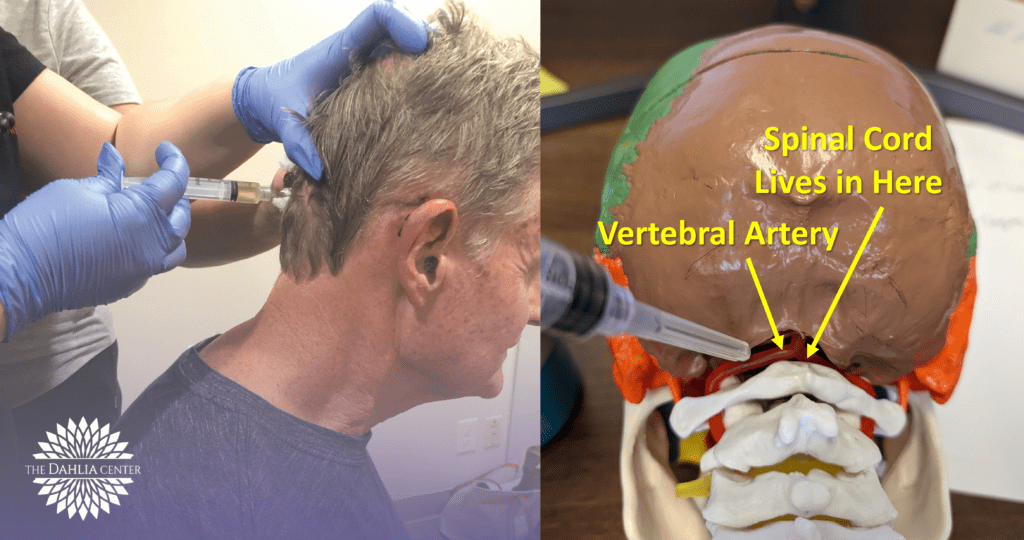
While it’s one thing to stick a 1-2 inch 22 gauge needle in an obese patient’s back and never come close to any important structures, it’s another thing to stick it blindly into the upper cervical spine. On the left above, that’s a 22 gauge needle inserted just to the left of the mid-line around C1. Let’s look at the anatomy of that area which I added to the right. The needle I have placed is just below the skull and just forward of that is the vertebral artery that supplies blood to the back of the brain. If you inadvertently inject into that artery, that could cause a posterior circulation stroke. Just deep to that is the spinal cord. If you inject there, the patient could end up a high quadriplegic and live their life in a sip and puff wheelchair. That’s if they survive.

One of the things that really disturbs me as an expert in spinal injections is the scary angle at which this upper neck needle is placed. So let’s learn something from this Facebook gaffe.
The image on the left above shows what’s concerning. By having the patient sit with the head slightly flexed, the angle of the needle is what will allow it to possibly slip into the “no go” zone. That’s shown by the red arrow. The green arrow shows the correct needle angle to perform this procedure (likely an attempt at an occipital nerve block). However, with the patient seated, that safe angle is almost impossible to replicate. Hence, the proper patient position for this procedure is lying face down as shown on the right. This allows you to get a safer angle (green arrow) that will place the needle against the skull into a “protected zone”. This also extends the neck, which closes off the “no go” zone. I also show the wrong injection angle in the prone procedure on the right (red arrow).
Where’s the Sterile Field?
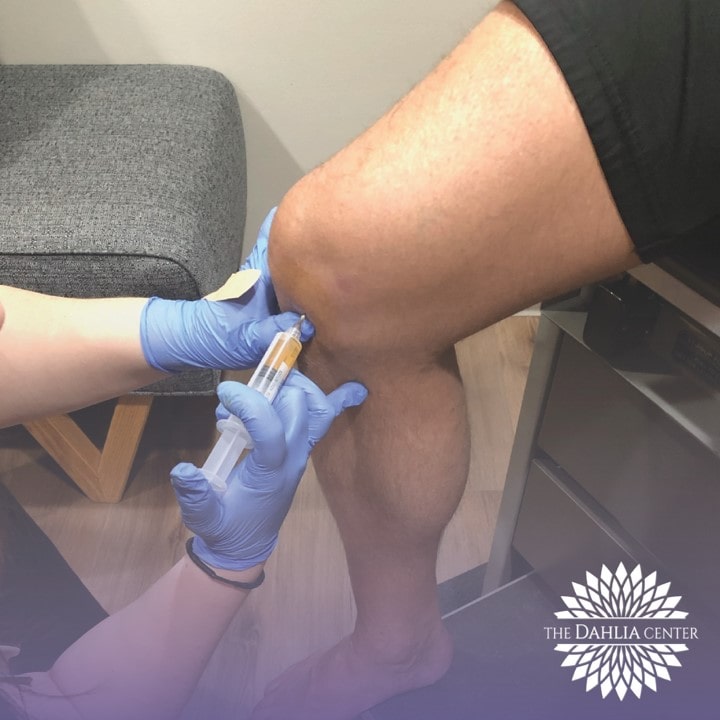
Next, we see a knee injection with a few problems. First, all intra-articular injections require a full sterile field with drapes and here we see none. Second, this also requires sterile gloves and these appear to be standard issue non-sterile exam gloves. Finally, in 2022, the standard of care for knee injections is to use at least ultrasound guidance for this procedure and not blind as shown.
Why is this technique a problem? First, the research shows that a blind injection like this can miss the actual knee joint and is associated with worse health outcomes (1-3). In addition, I’m the medical expert on several cases of infection caused by nurse practitioners who performed knee “stem cell” injections. One of those was in an old guy (not this clinic) who almost died because of severe sepsis. That happened because the nurse traveled to a chiropractic office for the injection and then left the clinic to manage the patient. The clinic didn’t have the expertise to figure out that the guy was getting septic. Thankfully his life was saved by his retired nurse spouse, but not before he went into renal failure.
Summing Up What We See on Facebook
In conclusion, the Dahlia Center offers very low-level injection care which based on what they have on Facebook is blind, meaning there is no imaging confirmation that the “stem cells” are being placed in the right spot. The upper neck injection concerns me, as I’ve seen providers use this blind approach in cadaver courses and inadvertently slip into the vertebral artery area or spinal canal. The knee injection shown, in my opinion, is well below the current standard of care.
At Home Injections?
My contact at the Dahlia Center stated that they would hire a nurse practitioner who would come to my house. That’s an interesting plan, as for the injections shown above, these need to be performed in a clinic where resuscitation equipment is readily available and other medical providers are around who can assist. I can’t imagine trying to resuscitate a patient solo and keep them safe until EMS arrived surrounded by freaked-out family members.
Also, realize that this mailer was sent to rural Wyoming. I reached out to my patient to inquire about the status of EMS in that setting and here’s what she wrote back:
“Laramie serves a large rural population, so time to ambulance up to an hour, to the hospital, even more.”
Enough said.
What Does the Dahlia Center Inject?
On their Facebook page, this bedside PRP centrifuge kit system is shown:
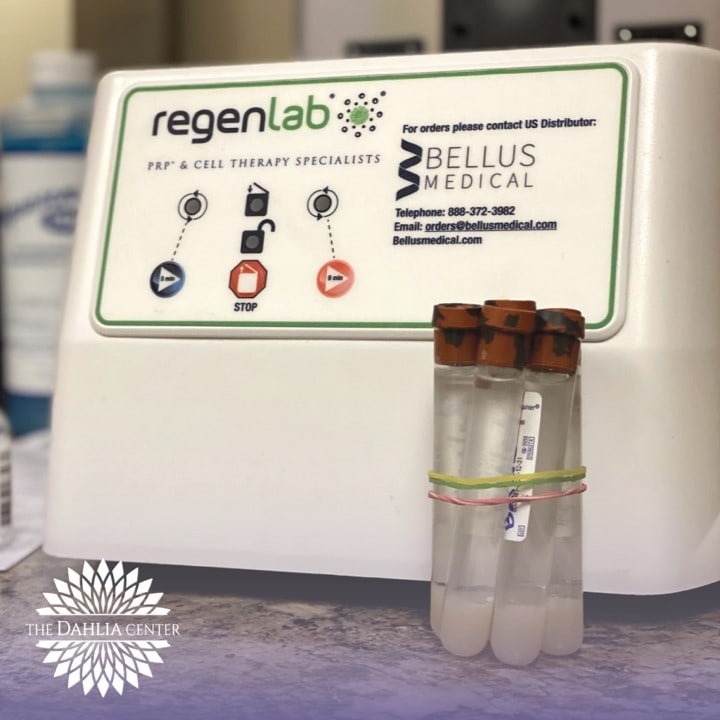
This is the now “infamous” Regen Lab kit featured in this blog on a university study that never actually injected PRP. That’s because according to Magalon et al, the kit has issues (4):
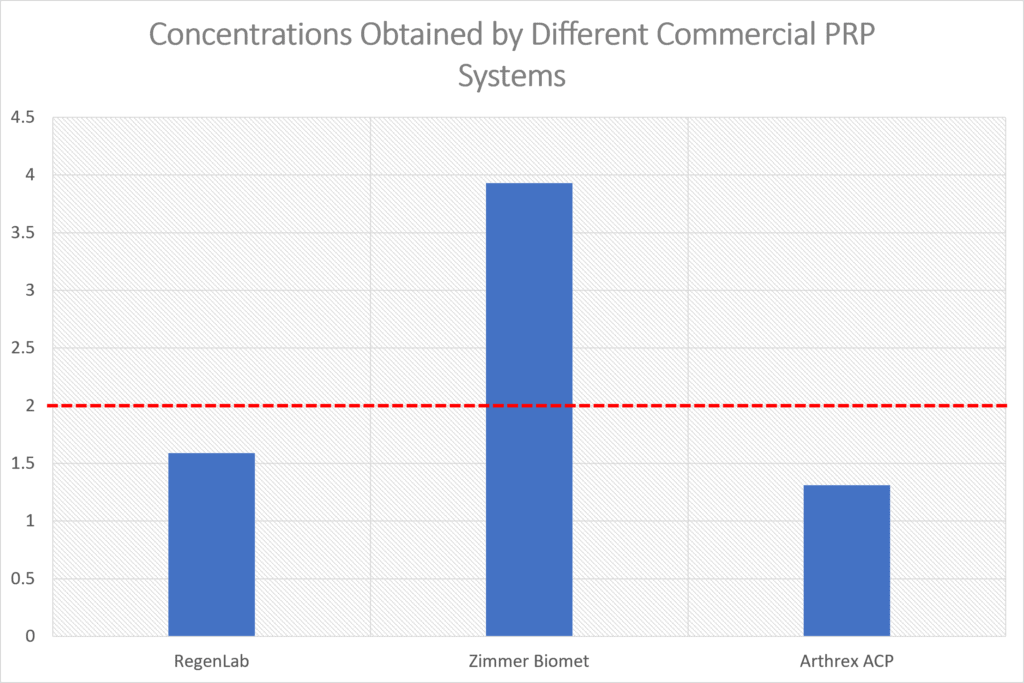
The dashed red line above is the minimum definition of PRP (5). As you can see, the RegenLab kit on the left produces “PRP” that is LESS concentrated than the minimum level that defines PRP. Hence, based on this Facebook post, even though the Dahlia Center claims to use PRP in its patients, it actually doesn’t use anything that meets the definition of PRP.
Next up we see an umbilical cord product the clinic shows us on its Facebook page:
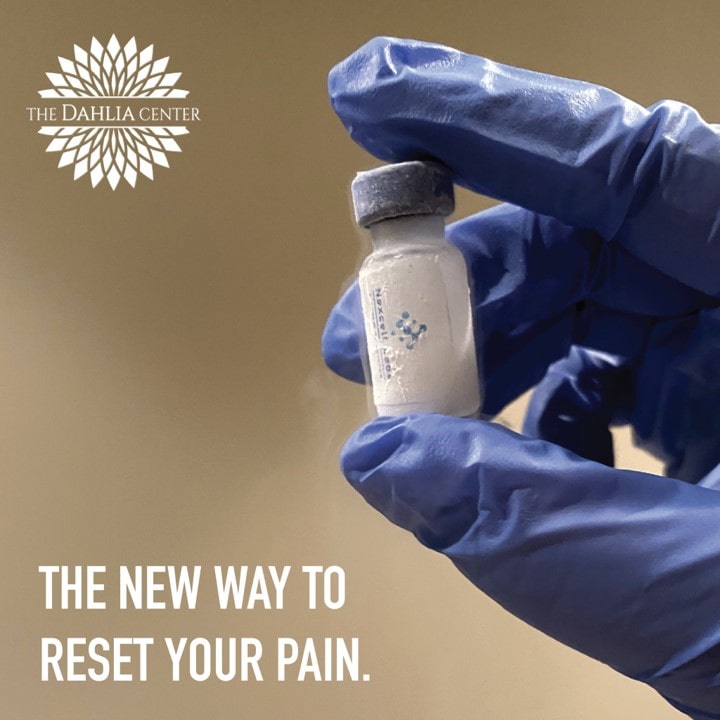
The label says “NexCell Labs”. There are a few issues here. If you read this blog, you know that US umbilical products like Nexcell have no living and functional stem cells. This is based on extensive peer-reviewed research (6-9). Hence, we have a claim in the flyer that in my opinion is consumer fraud. Meaning that Dahlia is claiming that it’s injecting stem cells that can regenerate tissue and the research shows that the product type used by the clinic contains no living and functional stem cells capable of regenerating tissue.
Who is NexCell?
Despite the FDA letter sent to The Dahlia Center, this is what NexCell currently has on Google:

In fact, the entire website for NexCell is summed up above. It’s all about selling vials of stem cells, which is clearly not FDA compliant. In addition, based on the peer-reviewed research, the company’s “stem cell” claim is false.
Teaching NPs?
As I said above, perhaps the most interesting part of all of this is that we have an Ohio clinic advertising in Wyoming. That works because the clinic hires a local NP to perform injections. There is one missing piece, however. How does the local provider get trained? Well, The Dahlia Center has that covered:
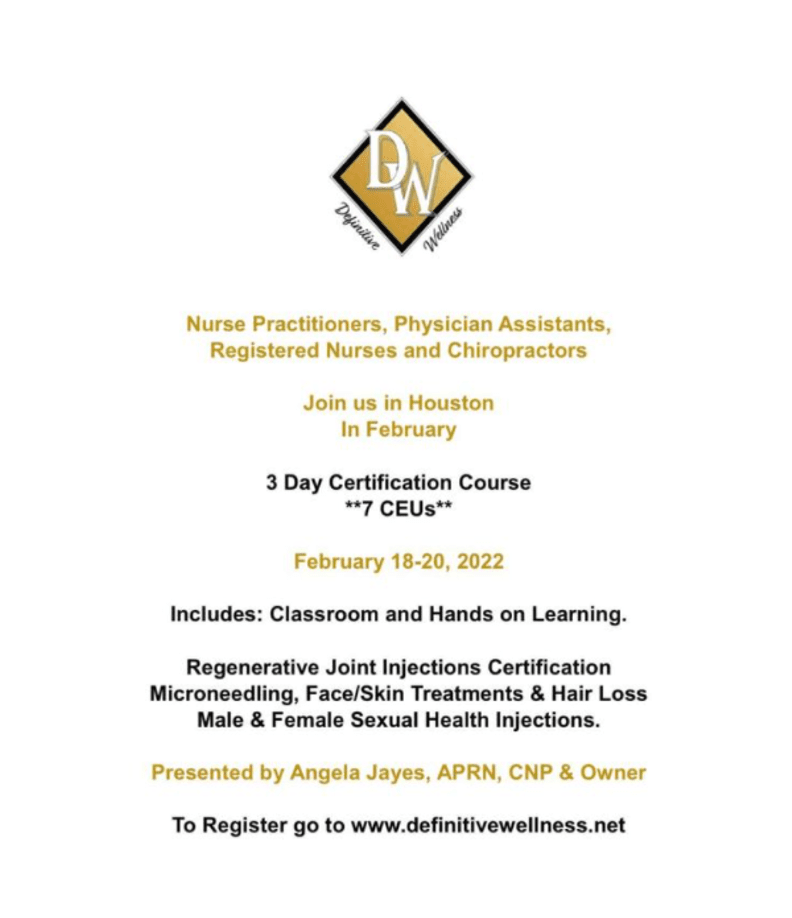
Definitive Wellness is a teaching company run by no other than Angela Jayes! The same nurse who demonstrated the procedural expertise shown above. She just ran a course certifying NPs in “Regenerative Joint Injections”.
The “Stem Cell” Road Show
I first heard about what I call “The ‘Stem Cell’ Roadshow” from a local chiropractic friend who told me that an out-of-town NP had contacted him about using his Boulder, Colorado office to treat “stem cell” patients on the weekends. While he turned this offer down, you can bet that someone took the money. Now that seems to have morphed into “at-home care”.
A Chinese Hamburger
This whole phenomenon of mid-level and alternative medicine clinics claiming to offer interventional orthobiologics reminds me of a business trip I took to China. While there, I ordered a hamburger through room service. What I got had some of the components of a hamburger, but was like a bad Chinese interpretation of that classic American dish. That’s what I see when I take a deep dive into these clinics. In my opinion, while what they offer may look like interventional orthobiologics, instead it’s always a far cry from the real deal.
The upshot? As I always say, you can’t make this stuff up! A clinic in Ohio run by a nurse offering to treat a patient in rural Wyoming! Add in the fact that this clinic loves to post what in my opinion are poorly performed injections on Facebook and I’m just blown away by the insanity of it all.
__________________________________________________
References:
(1) Bum Park Y, Ah Choi W, Kim YK, Chul Lee S, Hae Lee J. Accuracy of blind versus ultrasound-guided suprapatellar bursal injection. J Clin Ultrasound. 2012 Jan;40(1):20-5. doi: 10.1002/jcu.20890. Epub 2011 Oct 28. PMID: 22033897.
(2) Fang WH, Chen XT, Vangsness CT Jr. Ultrasound-Guided Knee Injections Are More Accurate Than Blind Injections: A Systematic Review of Randomized Controlled Trials. Arthrosc Sports Med Rehabil. 2021;3(4):e1177-e1187. Published 2021 Jun 26. doi:10.1016/j.asmr.2021.01.028
(3) Lundstrom ZT, Sytsma TT, Greenlund LS. Rethinking Viscosupplementation: Ultrasound- Versus Landmark-Guided Injection for Knee Osteoarthritis. J Ultrasound Med. 2020 Jan;39(1):113-117. doi: 10.1002/jum.15081. Epub 2019 Jun 25. PMID: 31237389.
(4) Magalon J, Bausset O, Serratrice N, Giraudo L, Aboudou H, Veran J, Magalon G, Dignat-Georges F, Sabatier F. Characterization and comparison of 5 platelet-rich plasma preparations in a single-donor model. Arthroscopy. 2014 May;30(5):629-38. doi: 10.1016/j.arthro.2014.02.020. PMID: 24725317.
(5) Marx RE. Platelet-rich plasma: evidence to support its use. J Oral Maxillofac Surg. 2004 Apr;62(4):489-96. doi: 10.1016/j.joms.2003.12.003. PMID: 15085519
(6) Berger D, Lyons N, Steinmetz, N. In Vitro Evaluation of Injectable, Placental Tissue-Derived Products for Interventional Orthopedics. Interventional Orthopedics Foundation Annual Meeting. Denver, 2015. https://interventionalorthopedics.org/wp-content/uploads/2017/08/AmnioProducts-Poster.pdf
(7) Panero AJ, Hirahara AM, Andersen WJ, Rothenberg J, Fierro F. Are Amniotic Fluid Products Stem Cell Therapies? A Study of Amniotic Fluid Preparations for Mesenchymal Stem Cells With Bone Marrow Comparison. Am J Sports Med. 2019 Apr;47(5):1230-1235. doi: 10.1177/0363546519829034. Epub 2019 Mar 7. PMID: 30844295.
(8) Becktell L, Matuska A, Hon S, Delco M, Cole B, Fortier L. Proteomic analysis and cell viability of nine amnion-derived biologics. Orthopedic Research Society Annual Meeting, New Orleans, 2018. https://app.box.com/s/vcx7uw17gupg9ki06i57lno1tbjmzwaf
(9) Berger DR, Centeno CJ, Kisiday JD, McIlwraith CW, Steinmetz NJ. Colony Forming Potential and Protein Composition of Commercial Umbilical Cord Allograft Products in Comparison With Autologous Orthobiologics. Am J Sports Med. 2021 Aug 16:3635465211031275. doi: 10.1177/03635465211031275. Epub ahead of print. PMID: 34398643.

NOTE: This blog post provides general information to help the reader better understand regenerative medicine, musculoskeletal health, and related subjects. All content provided in this blog, website, or any linked materials, including text, graphics, images, patient profiles, outcomes, and information, are not intended and should not be considered or used as a substitute for medical advice, diagnosis, or treatment. Please always consult with a professional and certified healthcare provider to discuss if a treatment is right for you.
